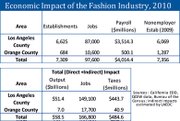Otis: Fashion's Role in 'Creative Economy'
The apparel industry is still the second-largest employer in the region’s creative economy, second only to the entertainment industry. But employment in all facets of the creative economy has declined 13.4 percent between 2005 and 2010.
That was the finding in the “2011 Otis Report on the Creative Economy,” conducted for the fifth year by the Otis School of Art and Design in Los Angeles and released on Nov. 9.
The creative economy includes Hollywood jobs, fashion industry companies, furniture workshops, toy designers and importers, art galleries, architects, interior designers, visual and performing arts, and industrial design. Out of 66 industrial clusters in the Los Angeles area, the creative industry is the fourth largest and is only smaller than health services, business-to-business services and hospitality.
Los Angeles–based firms in the creative economy employed 300,800 people and earned about $115 billion in revenues in 2010.
The entertainment industry made up the largest section of the creative industry, bringing in $48.4 billion in revenues and employing 119,200 people. The average annual salary in 2010 for the entertainment industry was $100,578.
The fashion industry was the second-largest component of the creative economy. It generated $32 billion in revenues and had 87,000 workers in Los Angeles County. But jobs in the apparel and textile industries have steadily declined by more than 15 percent in the last five years, the report said. Two fashion areas where employment has grown have been in apparel wholesaling and specialized design services.
Also, free-lance employment in the fashion industry saw fewer declines in employment than full-time employees. Between 2004 and 2009, the fashion industry saw a nearly 19 percent decline in employment while free-lance employment dropped only 10.7 percent. In 2010, some 6,000 free-lancers were working in the fashion industry, compared with 87,000 full-time employers, the report said.
The average annual salary for the apparel industry in 2010 was $40,405, taking into account that cutters and sewers earn less than designers or apparel company owners.
The report noted that the fashion and furniture industries have been shedding jobs for years because of a shift to offshore sourcing. Many of these jobs will not return.
However, the report foresees a 4.3 percent employment growth in the entire creative-economy sector over the next five years. The fashion industry will see a slight 2.5 percent uptick in employment. One fashion area that will lag behind is manufacturing and retail/wholesale levels as factory production increasingly moves overseas.
The one category that should see a healthy rise in jobs is the digital-media industry. It is one sector where employment remained relatively stable between 2008 and 2010, when the economic downturn was the worst. Employment in this area should grow 10 percent by 2015. Digital media covers areas such as video games and consumer hand-held devices.
The entertainment industry will also see robust growth with a 6.6 percent increase in jobs by 2015. Production activity and job counts have seen improvements in 2010 and 2011.—Deborah Belgum
RELATED STORIES
- Otis College of Art and Design Unveils Creative-Economy Report for California
- Otis Report: L.A.s’ Creative Economy Slowly Regaining Jobs, but Fashion Manufacturing Continues to Shrink
- New Study Reveals Impact of Creative Jobs on L.A. County’s Economy
- Jobs in the Creative Industries Take a Big Step Forward in California






















